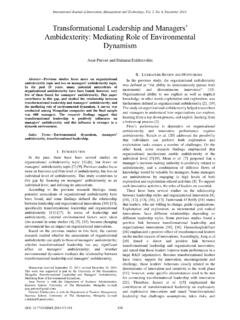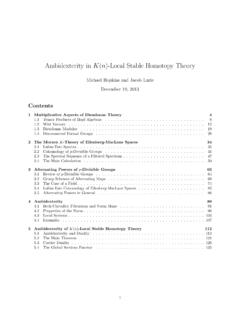Transcription of Beyond Motivation: Job and Work Design for Development ...
1 PS65CH24-ParkerARI31 October 201316:54 Beyond Motivation: Joband Work Design forDevelopment, health , ambidexterity , and MoreSharon K. ParkerThe University of Western Australia, Crawley, Perth, Western Australia 6009,Australia; email: Rev. Psychol. 2014. 65:661 91 First published online as a Review in Advance onSeptember 6, 2013 TheAnnual Review of Psychologyis online article s 2014 by Annual rights reservedKeywordsjob Design , autonomy, job enrichment, job characteristics, self-managingteamsAbstractMuch research shows it is possible to Design motivating work, which haspositive consequences for individuals and their organizations. This articlereviews research that adopts this motivational perspective on work Design ,and it emphasizes that it is important to continue to refine motivationaltheories.
2 In light of continued large numbers of poor-quality jobs, attentionmust also be given to influencing practice and policy to promote the effectiveimplementation of enriched work designs. Nevertheless, current and futurework-based challenges mean that designing work for motivation is necessarybut insufficient. This review argues that work Design can be a powerful vehi-cle for learning and Development , for maintaining and enhancing employees physical and mental health , and for achieving control and flexibility simulta-neously (for example, in the form of ambidexterity ); all these outcomes areimportant given the challenges in today s workplaces. The review concludesby suggesting methodological Rev. Psychol. :661-691. Downloaded from University of Minnesota - Twin Cities on 09/30/14. For personal use October 201316 662 Definitionand Brief History.
3 663 PART 1: MOTIVATIONALWORK Design 663 Established Motivational Perspectives: The Job Characteristics Model,Elaborations, and Group 663 Expanded Motivational Theories: Proactive, Prosocial, and Other Perspectives .. 667 Motivational Work Designin 670 PART 2: EXPANDED WORK Design 671 Designing Work for Learning and Development .. 672 DesigningWork forMental and Physical 676 Designing Work for Control and Flexibility: ambidexterity , EnablingBureaucracy, and High-Reliability Organizing .. 680 METHODOLOGICAL DIRECTIONS .. 684 SUMMARY ANDCONCLUSION .. 685 INTRODUCTIONTen hours(a day)is a long time just doing ve had three years in here and I m like, I m going to getthe hell s just the most boring work you can do. Ford autoworkerI love my ve learned so can talk with biochemists, software engineers, all these love being independent, relying on just do whatever works, it s exciting.
4 Corporate headhunterWe see about a hundred injuries a year and I m amazed there aren t more . The main causes are inexperienceand work the same job all the time and they stop thinking. Slaughterhouse human resources directorThese quotations, from a book in which Americans talk about their jobs (Bowe et al. 2000,pp. 38, 12, and 52, respectively), highlight the diverse outcomes one s work Design cancause. Work Design , or the content and organization of one s work tasks, activities, relation-ships, and responsibilities, has been linked to almost every end goal that is of concern in anorganization safety, performance, and innovation, to name a few. Work Design also mattersfor individuals; it affects their sense of meaning, their health , and their Development .
5 Onthe global front, the importance of work Design is exemplified by the International LaborOrganization s Decent Work Agenda, which focuses not just on obtaining work for all but onensuring quality work that provides better prospects for personal Development and freedomfor people to express their concerns, organize and participate in the decisions that affecttheir lives ( ). On thetheoretical front, Miner (2003) rated work Design theory as one of the few theories in the field oforganizational behavior that are simultaneously important, valid, and its salience for practice and policy, and its sound theoretical underpinning, work de-sign has not received the research attention that is warranted (Humphrey et al. 2007), especiallygiven radical shifts in work organization (Grant & Parker 2009).
6 As an example, work designhas not been the focus of any previous Annual Reviews article. The goal of this article is thus,662 ParkerAnnu. Rev. Psychol. :661-691. Downloaded from University of Minnesota - Twin Cities on 09/30/14. For personal use October 201316:54 Scientificmanagement:atheoryofmanagement focusedon achieving efficiencyby analyzing work andbreaking it down intosimplified carry outthe simplified taskswhile managers makedecisions and engagein mental workSociotechnicalsystems theory:theidea that the technicaland social aspects ofwork should be jointlyoptimized whendesigning workAutonomous workgroup:a group ofinterdependentmembers that havecollective autonomyover day-to-dayaspects of their workJob rotation:rotatingemployees from onejob to another jobJob enlargement:expanding the contentof jobs to includeadditional tasksJob enrichment.
7 Increasing employees autonomy over theplanning andexecution of their ownworkunashamedly, to help promote work Design research as a distinct area of psychological review has two parts. First, it discusses dominant motivational approaches to work challenges mean that designing work for motivation is necessary but insufficient,so the second part of the review identifies three goals of work Design that are central given en-hanced complexity in many workplaces: work Design for learning and Development , work designfor health and well-being, and work Design for the dual outcomes of control and flexibility. Inboth parts, the focus of this review is on more recent research and new theoretical directions[for further advances, see also the special issue of theJournal of Organizational Behavior, with anintroduction by Grant et al.]
8 (2010)]; for reviews of earlier work, the reader is referred to theonline reference list (follow the Supplemental Material link from the Annual Reviews home ). In addition, this review uses the term work Design insteadof job Design to reflect that the topic is concerned not only with employees prescribed technicaltasks within a fixed job but also with employee engagement in emergent, social, and self-initiatedactivities within flexible roles (Morgeson & Campion 2003, Parker & Wall 1998).Definition and Brief HistoryImagine designing the role of a police officer. Illustrative work Design decisions include the fol-lowing: Which activities should be grouped together to form a meaningful job? Which decisionsshould be made by officers and which by their supervisors? Should individual jobs be groupedtogether into a team?
9 Can one build in routine tasks amid complex ones to ensure officers arenot overwhelmed by demands? These decisions about the content and organization of officers tasks, activities, relationships, and responsibilities will affect outcomes at multiple levels, includingindividual officers, such as how engaged they feel or their level of strain; the wider organization,such as whether the police service achieves its targets; and society, such as how effectively crimeis detected and , interest in the topic of work Design arose in response to the wide-scale adoptionof scientific management principles in the Design of early industrial jobs. A key principle is jobsimplification, in which mental work is allocated to the managers while workers perform onlythe manual work. The negative consequences of job simplification, such as turnover, strikes,and absenteeism, prompted interest in redesigning work.
10 At the group level, the application ofsociotechnical systems theory led to the Design of autonomous work groups, which are still populartoday. At the individual level, job rotation, job enlargement, and job enrichment emerged asmotivational antidotes to simplified jobs; job enrichment is the most important of these approachesbecause of its emphasis on increasing employees autonomy. The theory underpinning these andrelated work redesigns, and research regarding their effects, is discussed 1: MOTIVATIONAL WORK Design PERSPECTIVESU nsurprisingly, given that work Design emerged from studies of alienating and meaningless jobs,psychological research on the subject has motivation at its core (Campion 1988). The first section ofPart 1 describes established motivational perspectives on work Design .









